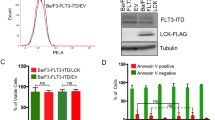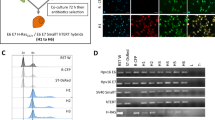Abstract
Overexpression of the high mobility group I (HMGI) proteins is often associated with the malignant phenotype. Moreover, many benign human tumors, mainly of mesenchymal origin, are characterized by rearrangements of the HMGI-C gene. In most cases, HMGI-C alterations involve breaks within the third intron of the gene resulting in aberrant transcripts carrying exons from 1–3, which encode the three DNA binding domains, fused to ectopic sequences. Here, we show that the expression of a truncated form of HMGI-C protein carrying only the three DNA-binding domains, or of a fusion protein carrying the three DNA-binding domains of HMGI-C and the LIM domains of the lipoma preferred partner gene (LPP) protein, causes malignant transformation of NIH3T3 cells. The unrearranged wild-type HMGI-C cDNA did not exert any transforming activity. These findings indicate that rearranged forms of HMGI-C play a role in cell transformation.
Similar content being viewed by others
Author information
Authors and Affiliations
Rights and permissions
About this article
Cite this article
Fedele, M., Berlingieri, M., Scala, S. et al. Truncated and chimeric HMGI-C genes induce neoplastic transformation of NIH3T3 murine fibroblasts. Oncogene 17, 413–418 (1998). https://doi.org/10.1038/sj.onc.1201952
Received:
Revised:
Accepted:
Published:
Issue Date:
DOI: https://doi.org/10.1038/sj.onc.1201952
- Springer Nature Limited
Keywords
This article is cited by
-
Emerging roles for LPP in metastatic cancer progression
Journal of Cell Communication and Signaling (2018)
-
Prognostic value of HMGA2, CDK4, and JUN amplification in well-differentiated and dedifferentiated liposarcomas
Modern Pathology (2015)
-
Rac1 and Cdc42 are regulators of HRasV12-transformation and angiogenic factors in human fibroblasts
BMC Cancer (2010)
-
Regulation of microRNA expression by HMGA1 proteins
Oncogene (2009)
-
Roles of HMGA proteins in cancer
Nature Reviews Cancer (2007)




